Digital Certificate Verification Scheme for Smart Grid using Fog Computing (FONICA)
Abstract
1. Introduction
1.1. Digital Certificates and Certification Authority (CA)
1.2. Role of Fog Computing in Security of SG
2. Literature Review
3. Problem Statement and Contribution
3.1. Problem Statement
3.2. Contribution
4. Materials and Methods
4.1. Background
4.2. Overview of the Proposed Methodology
4.3. Work Flow of the Proposed Methodology
4.4. Messaging System in the Proposed Methodolgy
4.5. Numerical Analysis
5. Results
6. Critical Analysis of the Proposed Scheme
7. Conclusions
Author Contributions
Funding
Institutional Review Board Statement
Informed Consent Statement
Data Availability Statement
Conflicts of Interest
References
- Kitajima, S.; Mambo, M. Verifying the Validity of Public Key Certificates Using Edge Computing. In International Conference on Security with Intelligent Computing and Big-data Services; Springer: Cham, Switzerland, 2017; pp. 330–336. [Google Scholar]
- Kim, S.M.; Lee, T.; Kim, S.; Park, L.W.; Park, S. Book Security Issues on Smart Grid and Blockchain-Based Secure Smart Energy Management System; EDP Sciences: Les Ulis, France, 2019; p. 01001. [Google Scholar]
- Kimani, K.; Oduol, V.; Langat, K. Cyber security challenges for IoT-based smart grid networks. Int. J. Crit. Infrastruct. Prot. 2019, 25, 36–49. [Google Scholar] [CrossRef]
- Alrawais, A.; Alhothaily, A.; Cheng, X.; Hu, C.; Yu, J. Secureguard: A certificate validation system in public key infrastructure. IEEE Trans. Veh. Technol. 2018, 67, 5399–5408. [Google Scholar] [CrossRef]
- Alrawais, A.; Alhothaily, A.; Hu, C.; Cheng, X. Fog computing for the internet of things: Security and privacy issues. IEEE Internet Comput. 2017, 21, 34–42. [Google Scholar] [CrossRef]
- Kakakhel, S.R.U.; Kondoro, A.; Westerlund, T.; Dhaou, I.B.; Plosila, J. Enhancing Smart Grids via Advanced Metering Infrastructure and Fog Computing Fusion. In Proceedings of the 2020 IEEE 6th World Forum on Internet of Things (WF-IoT), New Orleans, LA, USA, 2–16 June 2020; pp. 1–6. [Google Scholar]
- Pooja, M.; Yadav, M. Digital Signature. Int. J. Sci. 2018, 3, 71–75. [Google Scholar]
- Forcan, M.; Maksimović, M. Cloud-fog-based approach for smart grid monitoring. Simul. Model. Pract. Theory 2020, 101, 101988. [Google Scholar] [CrossRef]
- Mahmood, S.; Ullah, A.; Kayani, A.K. Fog Computing Trust based Architecture for Internet of Things Devices. Int. J. Comput. Commun. Netw. 2019, 1, 18–25. [Google Scholar]
- Sarkar, S.; Chatterjee, S.; Misra, S. Assessment of the Suitability of Fog Computing in the Context of Internet of Things. IEEE Trans. Cloud Comput. 2018, 6, 46–59. [Google Scholar] [CrossRef]
- Mukherjee, M.; Matam, R.; Shu, L.; Maglaras, L.; Ferrag, M.A.; Choudhury, N.; Kumar, V. Security and privacy in fog computing: Challenges. IEEE Access 2017, 5, 19293–19304. [Google Scholar] [CrossRef]
- Stojmenovic, I.; Wen, S. The fog computing paradigm: Scenarios and security issues. In Proceedings of the Federated Conference on Computer Science and Information Systems, Warsaw, Poland, 7–10 September 2014; pp. 1–8. [Google Scholar]
- Stojmenovic, I.; Wen, S.; Huang, X.; Luan, H. An overview of fog computing and its security issues. Concurr. Comput. Pract. Exp. 2016, 28, 2991–3005. [Google Scholar] [CrossRef]
- Ekanayake, B.N.; Halgamuge, M.N.; Syed, A. Security and Privacy Issues of Fog Computing for the Internet of Things (IoT). In Cognitive Computing for Big Data Systems Over IoT; Springer: Berlin/Heidelberg, Germany, 2018; pp. 139–174. [Google Scholar]
- Mollah, M.B.; Zhao, J.; Niyato, D.; Lam, K.-Y.; Zhang, X.; Ghias, A.M.; Koh, L.H.; Yang, L. Blockchain for future smart grid: A comprehensive survey. IEEE Internet Things J. 2020, 8, 18–43. [Google Scholar] [CrossRef]
- Chiang, M.; Zhang, T. Fog and IoT: An overview of research opportunities. IEEE Internet Things J. 2016, 3, 854–864. [Google Scholar] [CrossRef]
- Tariq, N.; Asim, M.; Al-Obeidat, F.; Zubair Farooqi, M.; Baker, T.; Hammoudeh, M.; Ghafir, I. The Security of Big Data in Fog-Enabled IoT Applications Including Blockchain: A Survey. Sensors 2019, 19, 1788. [Google Scholar] [CrossRef]
- Rowley, J. How Short-Lived Certificates Improve Certificate Trust. Available online: https://www.digicert.com/blog/short-lived-certificates/ (accessed on 4 February 2016).
- Khan, H. Cyber Security Challenges in Smart Grids. 2020. Available online: https://doi.org/10.31224/osf.io/ua3wp (accessed on 23 June 2020).
- Gunduz, M.Z.; Das, R. Cyber-security on smart grid: Threats and potential solutions. Comput. Netw. 2020, 169, 107094. [Google Scholar] [CrossRef]
- Fritz, J.J.; Sagisi, J.; James, J.; Leger, A.S.; King, K.; Duncan, K.J. Simulation of Man in the Middle Attack On Smart Grid Testbed. In Proceedings of the 2019 SoutheastCon, Huntsville, AL, USA, 11–14 April 2019; pp. 1–6. [Google Scholar]
- Kumar, V.; Kumar, R.; Pandey, S. LKM-AMI: A Lightweight Key Management Scheme for Secure two Way Communications between Smart Meters and HAN Devices of AMI System in Smart Grid. Peer--Peer Netw. Appl. 2020, 14, 82–100. [Google Scholar] [CrossRef]
- Ahmadiahangar, R.; Rosin, A.; Palu, I.; Azizi, A. Challenges of smart grids implementation. In Demand-side Flexibility in Smart Grid; Springer: Berlin/Heidelberg, Germany, 2020; pp. 1–15. [Google Scholar]
- Ali, S.S.; Choi, B.J. State-of-the-Art Artificial Intelligence Techniques for Distributed Smart Grids: A Review. Electronics 2020, 9, 1030. [Google Scholar] [CrossRef]
- Nejabatkhah, F.; Li, Y.W.; Liang, H.; Ahrabi, R.R. Cyber-Security of Smart Microgrids: A Survey. Energies 2021, 14, 27. [Google Scholar] [CrossRef]
- Mosenia, A.; Jha, N.K. A comprehensive study of security of internet-of-things. IEEE Trans. Emerg. Top. Comput. 2017, 5, 586–602. [Google Scholar] [CrossRef]
- Ghosal, A.; Conti, M. Key management systems for smart grid advanced metering infrastructure: A survey. IEEE Commun. Surv. Tutor. 2019, 21, 2831–2848. [Google Scholar] [CrossRef]
- Ahmad, M.; Younis, T.; Habib, M.A.; Ashraf, R.; Ahmed, S.H. A Review of Current Security Issues in Internet of Things. In Recent Trends and Advances in Wireless and IoT-enabled Networks; Springer: Berlin/Heidelberg, Germany, 2019; pp. 11–23. [Google Scholar]
- Qureshi, K.N.; Iftikhar, A. 6 Contemplating Security. In Security and Organization within IoT and Smart Cities; CRC Press: Boca Raton, FL, USA, 2020; p. 93. [Google Scholar]
- Cooper, D.; Santesson, S.; Farrell, S.; Boeyen, S.; Housley, R.; Polk, W. Internet X. 509 public key infrastructure certificate and certificate revocation list (CRL) profile. RFC 2008, 5280, 1–151. [Google Scholar]
- Stark, E.; Huang, L.-S.; Israni, D.; Jackson, C.; Boneh, D. The Case for Prefetching and Prevalidating TLS Server Certificates. In Proceedings of the 19th Annual Network & Distributed System Security Conference, San Diego, CA, USA, 5–8 February 2012. [Google Scholar]
- Cho, E.; Park, M.; Kwon, T. TwinPeaks: A new approach for certificateless public key distribution. Conference on Communications and Network Security (CNS), Philadelphia, PA, USA, 17–19 October 2016; pp. 10–18. [Google Scholar]
- Cebe, M.; Akkaya, K. Communication-efficient Certificate Revocation Management for Advanced Metering Infrastructure. arXiv 2019, arXiv:1902.04255. [Google Scholar] [CrossRef]
- Cebe, M.; Akkaya, K. Efficient Certificate Revocation Management Schemes for IoT-based Advanced Metering Infrastructures in Smart Cities. Ad Hoc Netw. 2019, 92, 101801. [Google Scholar] [CrossRef]
- Topalovic, E.; Saeta, B.; Huang, L.-S.; Jackson, C.; Boneh, D. Towards short-lived certificates. Web 2.0 Secur. Priv. 2012, 2012, 1–9. Available online: https://cseweb.ucsd.edu/~dstefan/cse127-winter19/papers/topalovic:towards.pdf (accessed on 24 May 2012).
- Masdari, M. Markov chain-based evaluation of the certificate status validations in hybrid MANETs. J. Netw. Comput. Appl. 2017, 80, 79–89. [Google Scholar] [CrossRef]
- Masdari, M.; Jabbehdari, S.; Bagherzadeh, J. Improving OCSP-based certificate validations in wireless ad hoc networks. Wirel. Pers. Commun. 2015, 82, 377–400. [Google Scholar] [CrossRef]
- Schulman, A.; Levin, D.; Spring, N. RevCast: Fast, private certificate revocation over FM radio. In Proceedings of the 2014 ACM SIGSAC Conference on Computer and Communications Security, Scottsdale, AZ, USA, 3–7 November 2014; pp. 799–810. [Google Scholar]
- Tschofenig, H.; Fossati, T. Transport Layer Security (TLS)/Datagram Transport Layer Security (DTLS) Profiles for the Internet of Things; IETF: California, CA, USA, 2016. [Google Scholar]
- Delgado-Gomes, V.; Martins, J.F.; Lima, C.; Borza, P.N. Smart grid security issues. In Proceedings of the 2015 9th International Conference on Compatibility and Power Electronics (CPE), Lisbon, Portugal, 24–26 June 2015; pp. 534–538. [Google Scholar]
- Samie, F.; Bauer, L.; Henkel, J. Edge computing for smart grid: An overview on architectures and solutions. In IoT for Smart Grids; Springer: Berlin/Heidelberg, Germany, 2019; pp. 21–42. [Google Scholar]
- Data Captured by IoT Connections to Top 1.6 Zettabytes in 2020, As Analytics Evolve from Cloud to Edge. 2015. Available online: https://www.abiresearch.com/press/data-captured-by-iot-connections-to-top-16-zettaby/ (accessed on 9 April 2015).
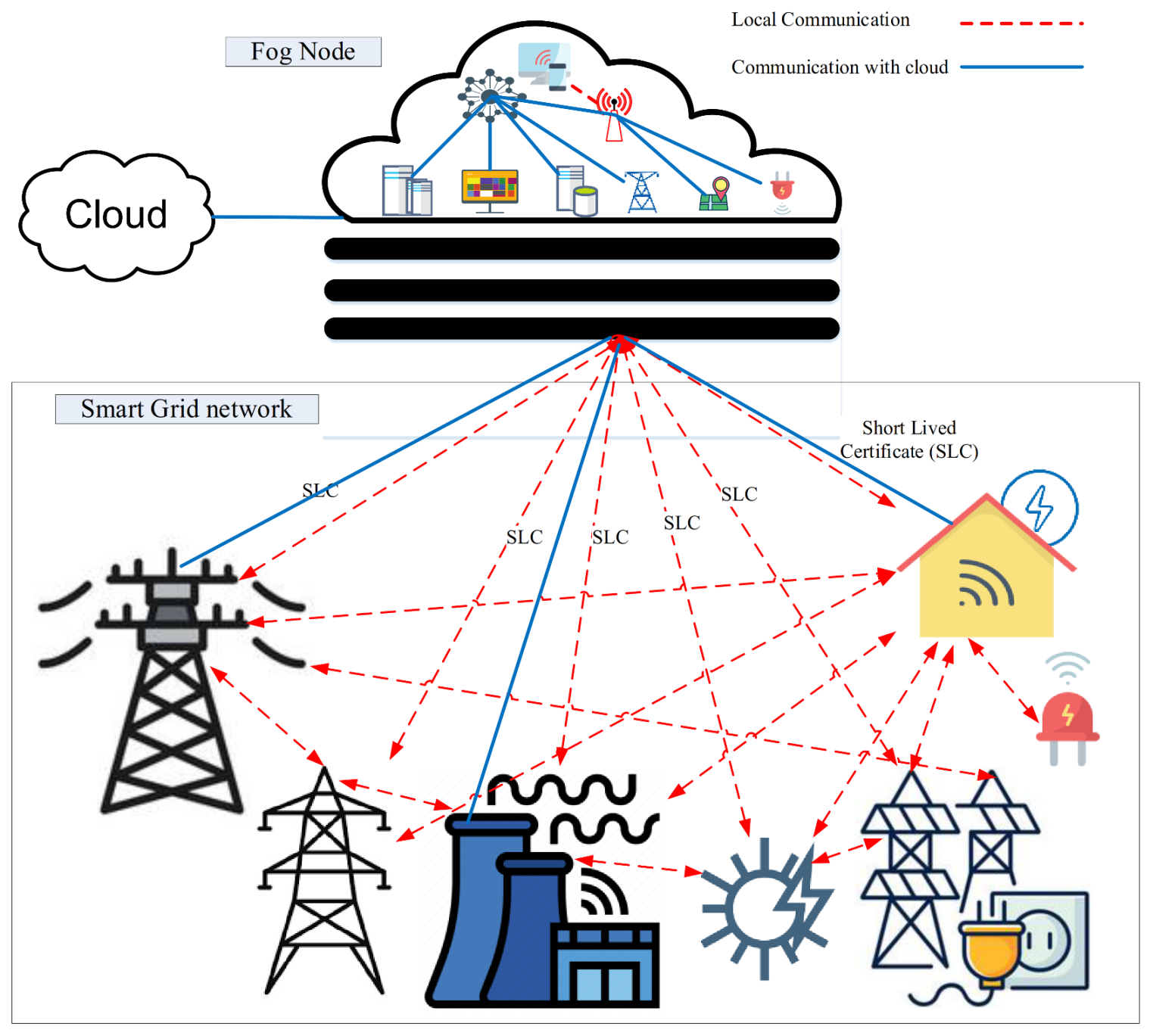

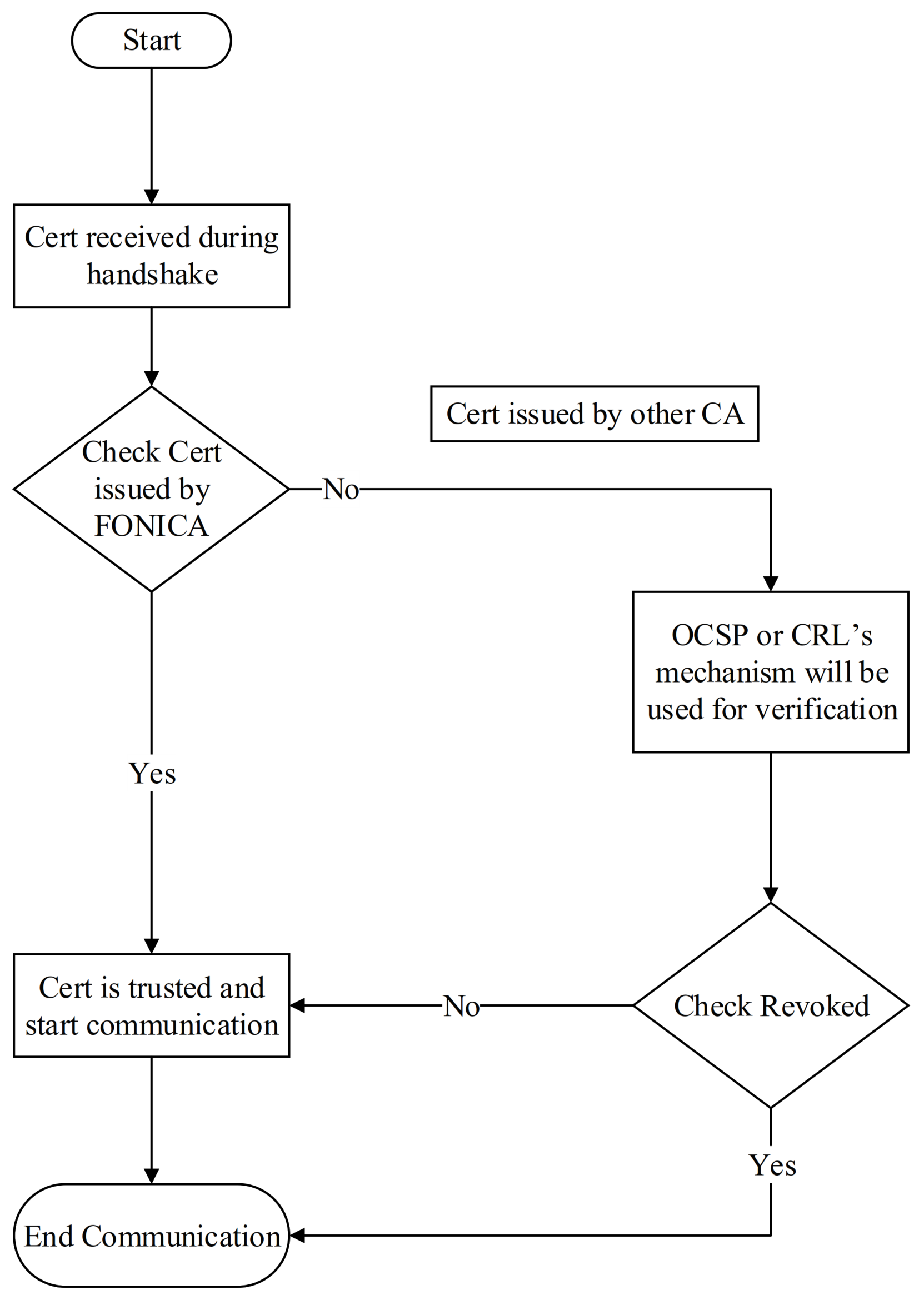

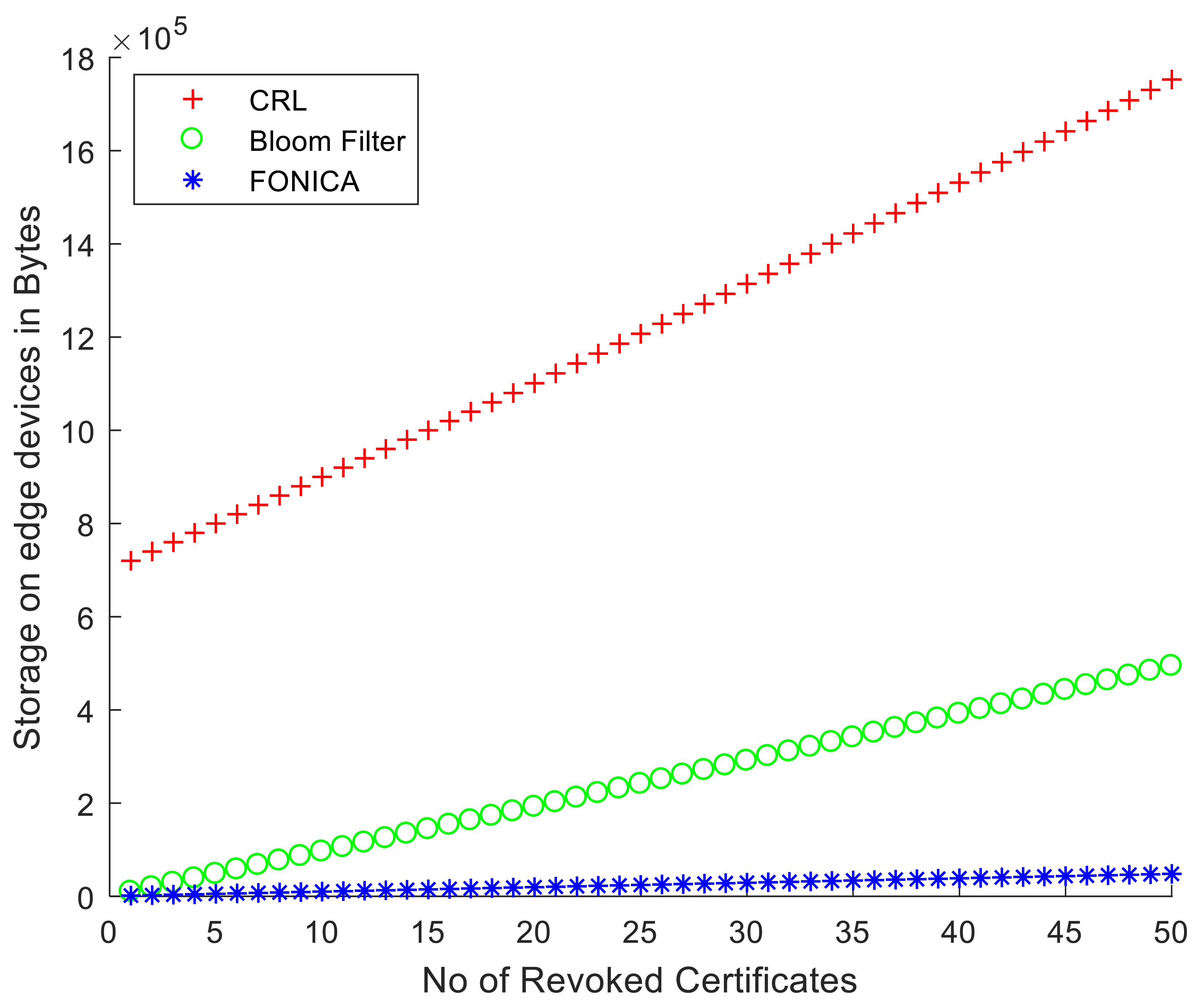
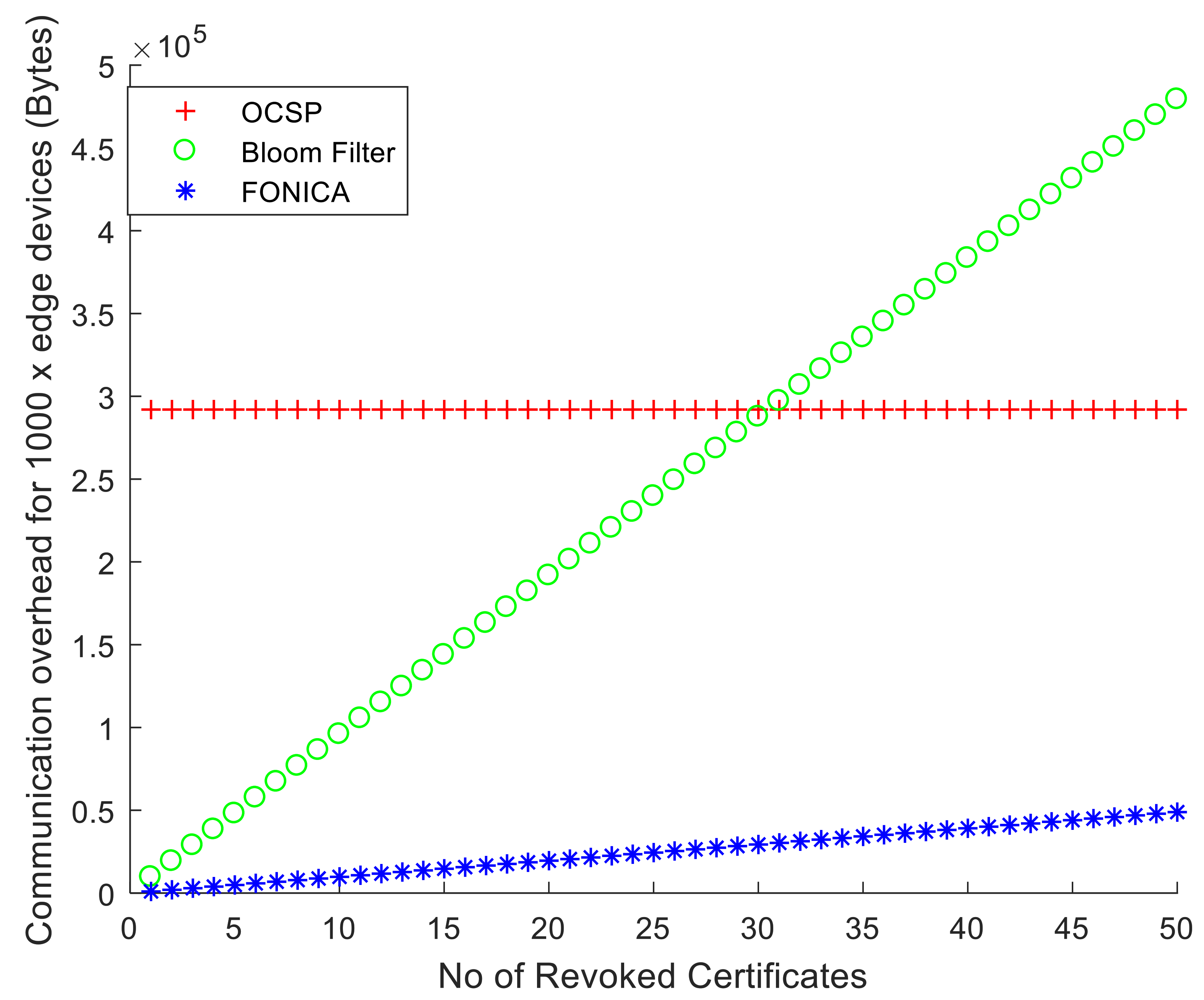
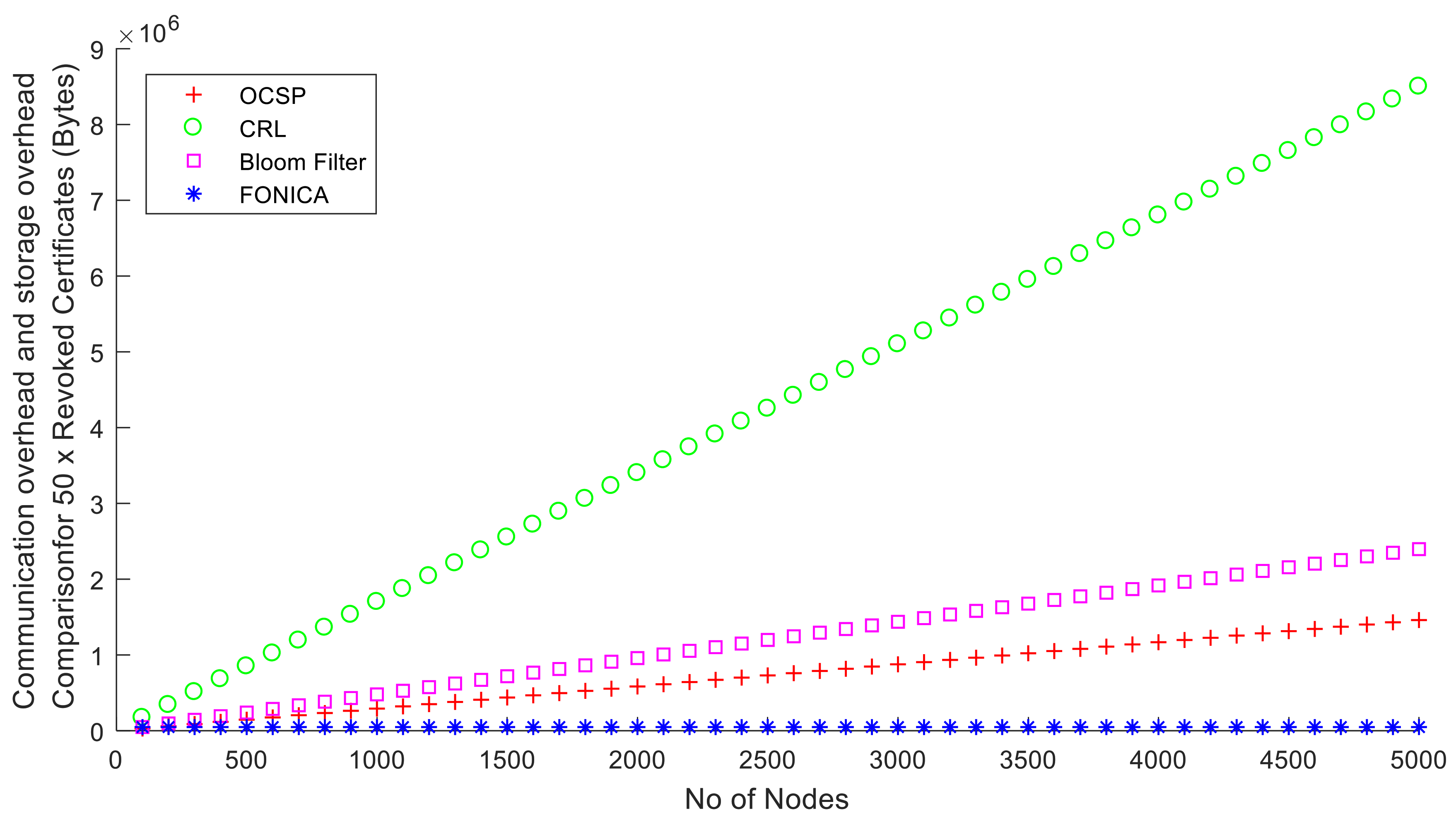
| Ser | Abbrivation | Meaning | Ser | Abbrivation | Meaning |
|---|---|---|---|---|---|
| 1 | SG | Smart Grid | 2 | CIA | Confidentiality, Integrity, and Availability |
| 3 | IoT | Internet of Things | 4 | PKI | Public Key Infrastructure |
| 5 | CA | Certification Authority | 6 | DTLS | Datagram Transport Layer Security |
| 7 | CRL | Certification Revocation List | 8 | IKE | Internet Key Exchange |
| 9 | OCSP | Online Certificate Status Protocol | 10 | TLS | Transport Layer Security |
| 11 | BF | Bloom Filter | 12 | ICT | Information and communications technology |
| 13 | SLC | Short-Lived Certificate | 14 | SSL | Secure Sockets Layer |
| 15 | DS | Digital Signatures | 16 | FONICA | Fog Node acting as intermediate certification Authority |
| 17 | IAS | Information Assurance Services | 18 | ADOPT | Ad-hoc Distributed OCSP for Trust |
| Ser | Service Name | Digital Certaddress? | How Digital Cert Achieve Service |
|---|---|---|---|
| 1 | Confidentiality | Yes | Secure exchange of Symmetric Key and Asymmetric Encryption |
| 2 | Integrity | Yes | Cryptographic hashes encrypt with private key |
| 3 | Availability | Yes | Protection against DoS Attack |
| 4 | Accountability | Yes | Usage of Private Keys |
| 5 | Auditability | Yes | Partial |
| 6 | Trustworthiness | Yes | Root CA and intermediate CA |
| 7 | Non-repudiation | Yes | Usage of Private Keys |
| 8 | Privacy | Yes | Secure exchange of Symmetric Key and Asymmetric Encryption |
| Ser | Scheme | Storage Issue | Processing Issue | Latency Issue | Communication Overhead | Remarks |
|---|---|---|---|---|---|---|
| 1 | CRL | ✓ | ✓ | ✕ | ✓ | CRL Size is issue |
| 2 | OCSP | ✕ | ✓ | ✓ | ✓ | Latency is issue |
| 3 | Bloom filter | ✕ | ✓ | ✓ | ✓ | Processing at edge node is issue |
| 4 | Twin-Peaks | ✕ | ✓ | ✕ | ✓ | Require infrastructure change |
| 5 | Secure Guard | ✕ | ✓ | ✕ | ✓ | Require infrastructure change |
| 6 | Distributed hash trees | ✕ | ✓ | ✕ | ✓ | Specific for Peer to Peer infrastructure |
| 7 | Short Lived Certificate | ✕ | ✓ | ✕ | ✓ | Huge Processing at Server |
| 8 | Lightweight X.509 Cert | ✕ | ✓ | ✕ | ✓ | Signature and the signature Algorithm fields are fixed to ECDSA with SHA256 |
| Variable/Symbol | Description | Values of variables |
|---|---|---|
| B | No of revoked Cert | b = 10, 30 and 50 |
| N | Total no of nodes under Area of FONICA | N = 1000 |
| S | Serial No. Certificate | S = 20 bytes |
| TCRL | Total storage will be consumed by edge devices for CRL Scheme | N × ((b × 20 + 700)) bytes |
| TBF | Total storage will be consumed by edge devices for Bloom Filter Scheme | TBF = N × |
| TOCSP | Total communication overhead for edge devices for OCSP Scheme | N × (292) bytes |
| TFONICA.CRL | Total storage will be consumed by edge devices for FONICA Scheme with CRL implementation. | TFONICA.CRL= (b − (b × 0.1)) × Cert_Size + (b×0.1× TCRL)) |
| TFONICA.OCSP | Total communication overhead for edge devices for FONICA Scheme with OCSP implementation. | TFONICA.OCSP = (b − (b × 0.1)) × Cert_Size + (b × 0.1 × TOCSP)) |
| P | p is the chosen probability of a false positive, which is 0.01 in Bloom Filter experiment | P = 0.01 |
| Cert_Size | 54 x Certificates collected and average certificate size is considered for computations. | Cert_Size = 1054 Bytes |
Publisher’s Note: MDPI stays neutral with regard to jurisdictional claims in published maps and institutional affiliations. |
© 2021 by the authors. Licensee MDPI, Basel, Switzerland. This article is an open access article distributed under the terms and conditions of the Creative Commons Attribution (CC BY) license (http://creativecommons.org/licenses/by/4.0/).
Share and Cite
Mahmood, S.; Gohar, M.; Choi, J.-G.; Koh, S.-J.; Alquhayz, H.; Khan, M. Digital Certificate Verification Scheme for Smart Grid using Fog Computing (FONICA). Sustainability 2021, 13, 2549. https://doi.org/10.3390/su13052549
Mahmood S, Gohar M, Choi J-G, Koh S-J, Alquhayz H, Khan M. Digital Certificate Verification Scheme for Smart Grid using Fog Computing (FONICA). Sustainability. 2021; 13(5):2549. https://doi.org/10.3390/su13052549
Chicago/Turabian StyleMahmood, Shahid, Moneeb Gohar, Jin-Ghoo Choi, Seok-Joo Koh, Hani Alquhayz, and Murad Khan. 2021. "Digital Certificate Verification Scheme for Smart Grid using Fog Computing (FONICA)" Sustainability 13, no. 5: 2549. https://doi.org/10.3390/su13052549
APA StyleMahmood, S., Gohar, M., Choi, J.-G., Koh, S.-J., Alquhayz, H., & Khan, M. (2021). Digital Certificate Verification Scheme for Smart Grid using Fog Computing (FONICA). Sustainability, 13(5), 2549. https://doi.org/10.3390/su13052549









